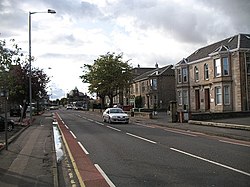Grangemouth
| Grangemouth | |
| Stirlingshire | |
|---|---|
 Grangemouth Refinery, dawn | |
| Location | |
| Grid reference: | NS935815 |
| Location: | 56°-0’43"N, 3°42’59"W |
| Data | |
| Population: | 17,906 (2001) |
| Post town: | Grangemouth |
| Postcode: | FK3 |
| Dialling code: | 01324 |
| Local Government | |
| Council: | Falkirk |
| Parliamentary constituency: |
Linlithgow |
Grangemouth is a major port town in Stirlingshire. It stands in the Forth Valley, on the banks of the Firth of Forth, 2½ miles east of Falkirk, four miles west of Bo'ness and almost three miles miles south-east of Stirling. Grangemouth had a resident population of 17,906 according to the 2001 census.
Grangemouth's growth as a town relied mainly on its geographical location. Originally a bustling port, trade flowed through the town with the construction of the Forth and Clyde Canal in the 18th century. Nowadays, the economy of Grangemouth is focused primarily on the large petrochemical industry of the area which includes the Grangemouth Refinery, an oil refinery, owned by Ineos, one of the largest of its kind in Europe.[1]
The town and location

Grangemouth, along with its surrounding areas, has become one of the most sought after commercial locations in the Central Highlands due to ease of access: the M9 motorway runs straight through the heart of the town. Grangemouth has access to three nearby railway stations, Falkirk High, Falkirk Grahamston, and Polmont.
Churches
- Church of Scotland
- Episcopal Church of Scotland: St Mary's
- Independent evangelical:
- Salvation Army
- Roman Catholic:
- Sacred Heart Church
- St Francis & Xaviers
History
Grangemouth was founded by Sir Lawrence Dundas in 1768 during the construction of the Forth and Clyde Canal. Originally under the name of Sealock,[2] which referred to the Forth and Clyde Canal and where it flowed into the River Forth.[3] The town was then renamed Grangeburnmouth and then finally Grangemouth, the present day name.[2] This refers to its position at the mouth of the Grange Burn which flows into the River Forth at this point.

As canal traffic that passed through the town the area became more prosperous, this was aided by the high tariffs at the port of Leith which caused more traffic to pass through Grangemouth instead. (The re-opened canal no longer passes through the old part of Grangemouth, but joins the tidal River Carron, which has been deepened to allow access to the River Forth for canal traffic.)
After Sir Lawrence died in 1781 his son Thomas Dundas commissioned the architect Henry Holland[4] to re-plan the town, he designed the layout around the canal and its basin.
During Second World War, Inchyra Road was used as a runway; Canadian and Polish servicemen were based there.
Economy


Grangemouth Port is one of the main ports in the United Kingdom and has the largest container terminal in Scotland, with 9 million tons of cargo handled through the dock facilities each year.[5] There are links to the inter-modal freight facilities elsewhere in the town which use the town's motorway connections. The town is equidistant between the two largest cities in Scotland - Glasgow and Edinburgh - which has led to a number of motels and hotels being set up to satisfy the demand for convenient, but lower-cost tourist and business accommodation.
The main industry of Grangemouth and the wider Falkirk council area is focused on the Grangemouth Refinery which employs a significant workforce and is one of the largest of its kind in Europe.
The Soap Works building which was used to manufacture soap and glycerine, and owned by the Scottish Co-operative Wholesale Society was established in 1897. This was the largest works of its kind in Scotland and employed a considerable number of local people. It was demolished in November 2005 to make way for a new Whyte and Mackay blending and bottling plant.
Big Society
Grangemouth has an Air Training Corps Squadron, 1333 (Grangemouth) Squadron (located at the TA Centre in Central Avenue), an Army Cadet Detachment (also in Central Avenue) and a Sea and Marine cadet corps at Grangemouth Docks.
Outside links
- Parish of Grangemouth by Rev. Hugh R. Thom
- Historical perspective, drawn from the Ordnance Gazetteer of Scotland
- Grangemouth Rugby Club
- Photographs of 1980s Grangemouth
References
- ↑ INEOS - About us - Grangemouth, www.ineosopportunities.co.uk. Retrieved 2011-05-13
- ↑ 2.0 2.1 History of Grangemouth, www.falkirkonline.net. Retrieved 2011-05-13
- ↑ Timeline History of Grangemouth, visitoruk.com. Retrieved 2011-05-13
- ↑ pages 59-60, Dorothy Stroud, Henry Holland His Life and Architecture, 1966, Country Life
- ↑ Forth Ports, www.forthports.co.uk. Retrieved 2011-05-13